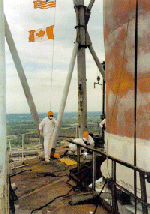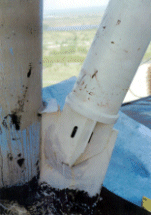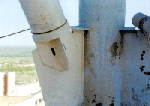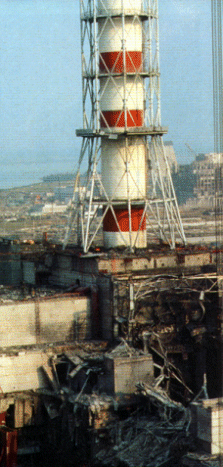Increasing the Safety of Day-to-Day Operations
Repairing the Damaged Ventilation Stack at Chornobyl
|
US Dept. of Energy 19901 Germantown Road Germantown, MD 20874 (301) 903-0234 |
In June 1998, workers finished stabilizing a ventilation stack damaged by the 1986 nuclear accident at Chornobyl. The 210-foot-high ventilation stack sits atop a 200-foot-high building between Chornobyl's operating Unit 3 reactor and the "shelter" that encloses the radioactive ruins of Unit 4. The stack still is used in Unit 3 operations. External braces support the stack and secure it to the building underneath. The braces, however, were damaged in the 1986 explosion. Flying debris severed horizontal bracing, bent and dented diagonal bracing, and tore connections. Vertical supports of the stack's foundation were bent nearly five degrees off alignment.
Calculations showed the stack's stability was reduced by 75 percent. The stack could topple in an earthquake or severe weather, such as high winds or a heavy load of snow. Depending on which way the stack fell, it could injure site personnel and damage either the shelter or the operating Unit 3 reactor. If the stack fell on the shelter, it could damage or crush the roof, sending radioactive dust across the site. If it fell on the operating reactor, it could cause damage to nuclear systems. The repairs restored the stack to its original stability. Repair Approach Extensive stack repairs were necessary. Nine badly damaged braces needed replacement. The stack's vertical steel foundation supports, bent by the explosion, needed to be stabilized with new concrete foundations. They also needed to be strengthened with vertical metal beams (called "strongbacks") welded along their lengths. The overriding concern in project planning, however, was the high radiation level around the stack. The explosion imbedded highly radioactive reactor fuel in the stack's paint. To minimize worker exposure, U.S. and Ukrainian experts developed a work plan that included conducting additional decontamination and building a full-size mock-up of a portion of the stack. The mock-up enabled workers to practice repair tasks without exposure to radiation. The work plan also included the development of repair equipment and a parts-delivery system to minimize radiation exposure. Personnel movements and routes through radiation areas were based on ALARA principles--methods for keeping personnel radiation dose "as low as reasonably achievable." The Chornobyl Shelter Organization developed the original work plan in early 1997 and asked U.S. experts to review it. A team from the Pacific Northwest National Laboratory, Chornobyl, and the Ukrainian contractor Ukrenergobud revised the plan to reduce workers' radiation exposure from 4,600 to approximately 400 person-rem. The revised plan also reduced the completion time from 4,200 to 1,700 worker-hours and the projected cost by 50 percent. Chornobyl managers accepted the team's recommendations and made similar comprehensive reviews standard for future high-exposure jobs. With the concurrence of the G-7 Nuclear Safety Working Group, the United States, Canada, and Ukraine agreed in December 1997 to fund the $2.25 million project. The United States contributed $1 million, Canada $800,000, and Ukraine $450,000. Repair Schedule Repair work began on April 23, 1998. The Ukrainian contractor Ukrenergobud conducted the work, under the technical management of the Shelter Organization. Fifty percent of the repairs were performed by May 9. By June 12, all 20 of the structurally significant damaged sites were repaired by completely replacing nine badly damaged frame members and by welding "strongbacks" over 11 significant dents. The work restores the structure to 100 percent of its original stability. Key Accomplishments The stabilization of the ventilation stack has provided a significant physical improvement to safety at the Chornobyl nuclear power plant. This project demonstrated that Ukrainian organizations can do high-quality project work, on schedule and within budget, as part of an international team. |
 Chornobyl workers perform final on-site welding. |
 |
 Lower junctions of the replacement brace. |
 Reinforcement of a damaged structural element. |
